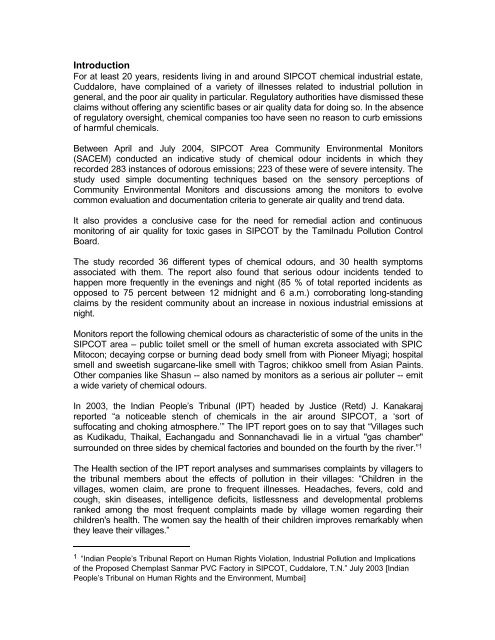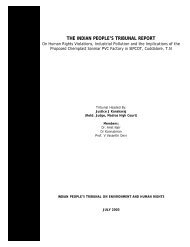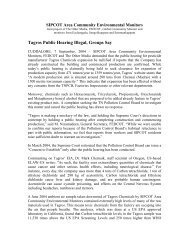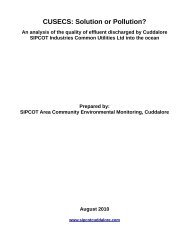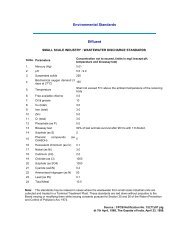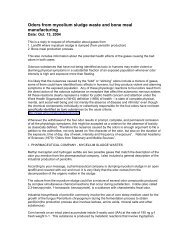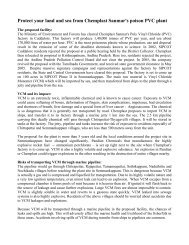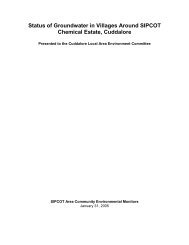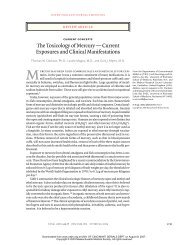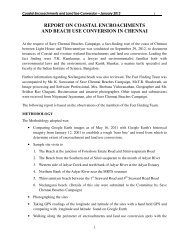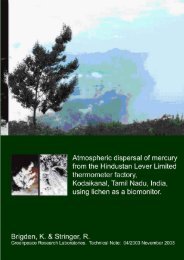Chemical Odour Incidents in SIPCOT Industrial Area, Cuddalore
Chemical Odour Incidents in SIPCOT Industrial Area, Cuddalore
Chemical Odour Incidents in SIPCOT Industrial Area, Cuddalore
You also want an ePaper? Increase the reach of your titles
YUMPU automatically turns print PDFs into web optimized ePapers that Google loves.
Introduction<br />
For at least 20 years, residents liv<strong>in</strong>g <strong>in</strong> and around <strong>SIPCOT</strong> chemical <strong>in</strong>dustrial estate,<br />
<strong>Cuddalore</strong>, have compla<strong>in</strong>ed of a variety of illnesses related to <strong>in</strong>dustrial pollution <strong>in</strong><br />
general, and the poor air quality <strong>in</strong> particular. Regulatory authorities have dismissed these<br />
claims without offer<strong>in</strong>g any scientific bases or air quality data for do<strong>in</strong>g so. In the absence<br />
of regulatory oversight, chemical companies too have seen no reason to curb emissions<br />
of harmful chemicals.<br />
Between April and July 2004, <strong>SIPCOT</strong> <strong>Area</strong> Community Environmental Monitors<br />
(SACEM) conducted an <strong>in</strong>dicative study of chemical odour <strong>in</strong>cidents <strong>in</strong> which they<br />
recorded 283 <strong>in</strong>stances of odorous emissions; 223 of these were of severe <strong>in</strong>tensity. The<br />
study used simple document<strong>in</strong>g techniques based on the sensory perceptions of<br />
Community Environmental Monitors and discussions among the monitors to evolve<br />
common evaluation and documentation criteria to generate air quality and trend data.<br />
It also provides a conclusive case for the need for remedial action and cont<strong>in</strong>uous<br />
monitor<strong>in</strong>g of air quality for toxic gases <strong>in</strong> <strong>SIPCOT</strong> by the Tamilnadu Pollution Control<br />
Board.<br />
The study recorded 36 different types of chemical odours, and 30 health symptoms<br />
associated with them. The report also found that serious odour <strong>in</strong>cidents tended to<br />
happen more frequently <strong>in</strong> the even<strong>in</strong>gs and night (85 % of total reported <strong>in</strong>cidents as<br />
opposed to 75 percent between 12 midnight and 6 a.m.) corroborat<strong>in</strong>g long-stand<strong>in</strong>g<br />
claims by the resident community about an <strong>in</strong>crease <strong>in</strong> noxious <strong>in</strong>dustrial emissions at<br />
night.<br />
Monitors report the follow<strong>in</strong>g chemical odours as characteristic of some of the units <strong>in</strong> the<br />
<strong>SIPCOT</strong> area – public toilet smell or the smell of human excreta associated with SPIC<br />
Mitocon; decay<strong>in</strong>g corpse or burn<strong>in</strong>g dead body smell from with Pioneer Miyagi; hospital<br />
smell and sweetish sugarcane-like smell with Tagros; chikkoo smell from Asian Pa<strong>in</strong>ts.<br />
Other companies like Shasun -- also named by monitors as a serious air polluter -- emit<br />
a wide variety of chemical odours.<br />
In 2003, the Indian People’s Tribunal (IPT) headed by Justice (Retd) J. Kanakaraj<br />
reported “a noticeable stench of chemicals <strong>in</strong> the air around <strong>SIPCOT</strong>, a ‘sort of<br />
suffocat<strong>in</strong>g and chok<strong>in</strong>g atmosphere.’” The IPT report goes on to say that “Villages such<br />
as Kudikadu, Thaikal, Eachangadu and Sonnanchavadi lie <strong>in</strong> a virtual "gas chamber"<br />
surrounded on three sides by chemical factories and bounded on the fourth by the river.” 1<br />
The Health section of the IPT report analyses and summarises compla<strong>in</strong>ts by villagers to<br />
the tribunal members about the effects of pollution <strong>in</strong> their villages: “Children <strong>in</strong> the<br />
villages, women claim, are prone to frequent illnesses. Headaches, fevers, cold and<br />
cough, sk<strong>in</strong> diseases, <strong>in</strong>telligence deficits, listlessness and developmental problems<br />
ranked among the most frequent compla<strong>in</strong>ts made by village women regard<strong>in</strong>g their<br />
children's health. The women say the health of their children improves remarkably when<br />
they leave their villages.”<br />
1 “Indian People’s Tribunal Report on Human Rights Violation, <strong>Industrial</strong> Pollution and Implications<br />
of the Proposed Chemplast Sanmar PVC Factory <strong>in</strong> <strong>SIPCOT</strong>, <strong>Cuddalore</strong>, T.N.” July 2003 [Indian<br />
People’s Tribunal on Human Rights and the Environment, Mumbai]


